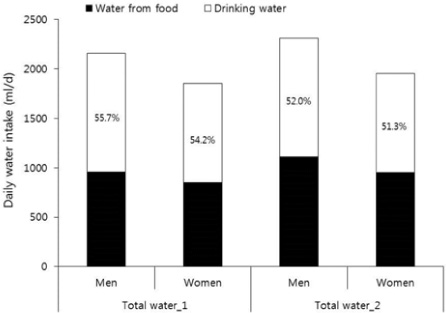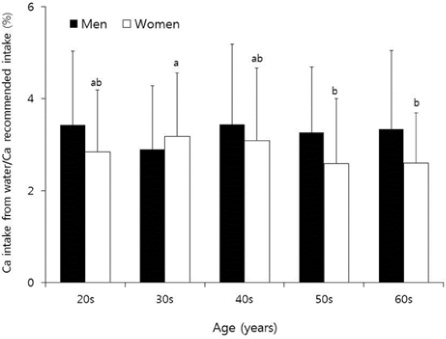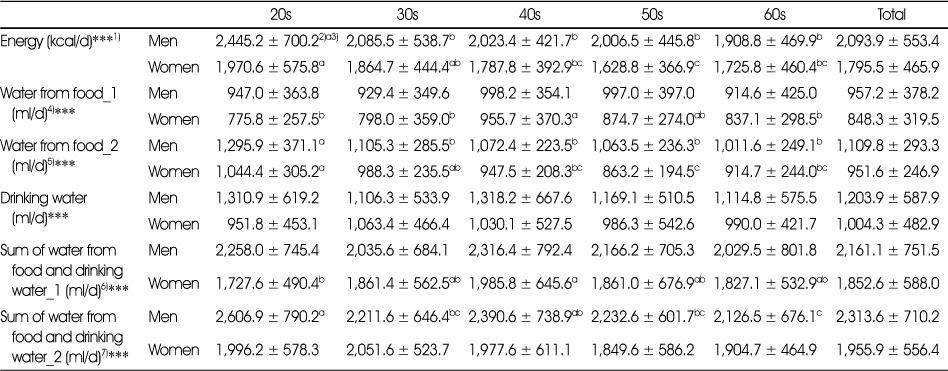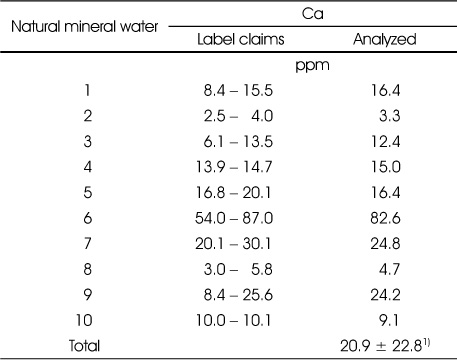Articles
- Page Path
- HOME > Korean J Community Nutr > Volume 24(1); 2019 > Article
-
Research Article
- Daily Water Consumption and its Contribution to Calcium Intake in Korean Adults
-
Eun-Sun Park, Yeon-Kyung Lee, Mi-Hyun Kim, Mi-Kyeong Choi

-
Korean Journal of Community Nutrition 2019;24(1):18-23.
DOI: https://doi.org/10.5720/kjcn.2019.24.1.18
Published online: February 28, 2019
1Division of Food Science, Kongju National University, Yesan, Korea, Student.
2Department of Food Science and Nutrition, Kyungpook National University, Daegu, Korea, Professor.
3Division of Food Science, Kongju National University, Yesan, Korea, Professor.
- Corresponding author: Mi-Kyeong Choi. Division of Food Science, Kongju National University, Yesan 32439, South Korea. Tel: (041) 330-1462, Fax: (041) 330-1469, mkchoi67@kongju.ac.kr
Copyright © 2019 The Korean Society of Community Nutrition
This is an Open-Access article distributed under the terms of the Creative Commons Attribution Non-Commercial License (http://creativecommons.org/licenses/by-nc/3.0/) which permits unrestricted non-commercial use, distribution, and reproduction in any medium, provided the original work is properly cited.
- 614 Views
- 1 Download
- 2 Crossref
Abstract
-
Objectives
- Although water is essential for life and can supply essential minerals, studies that evaluate calcium intake through drinking water are limited. The aim of this study was to assess calcium contents of natural mineral water (NMW) and its possible contribution to calcium intake in healthy adults.
-
Methods
- This study examined water consumption in 640 Korean adults with self-selected diet, analyzed the calcium content of 10 different brands of bottled NMWs sold in Korea, and assessed the amount of calcium intake from drinking water and its daily contribution to the recommended nutrient intake (RNI) of calcium.
-
Results
- Mean calcium content in 10 bottled NMWs was 20.9 mg/l. Daily water intakes from food composition database and calculated using energy intake based on 0.53 ml/kcal were 957.2 ml and 1109.8 ml for men and 848.3 ml and 951.6 ml for women, respectively, with a significant difference by gender (p<0.001). Daily drinking water intake was significantly higher among men than women (1203.9 ml vs. 1004.3 ml, respectively, p<0.001). Daily calcium intakes from foods were 564.0 mg for men and 534.2 mg for women. Daily possible calcium intakes from drinking bottled water were 25.2 mg for men and 21.0 mg for women (p<0.001). The contribution of daily calcium intake from drinking bottled water to RNI of calcium was 3.3% for men and 2.9% for women without significant difference.
-
Conclusions
- One half of the daily total water intake was consumed as drinking water, and possible calcium intake through drinking water was about 3% of RNI.
Introduction
Methods
Results
Discussion
Conclusions
- 1. Daniels MC, Popkin BM. Impact of water intake on energy intake and weight status: a systematic review. Nutr Rev 2010; 68(9): 505-521.ArticlePubMed
- 2. Popkin BM, D'Anci KE, Rosenberg IH. Water, hydration, and health. Nutr Rev 2010; 68(8): 439-458.ArticlePubMed
- 3. Ministry of Health and Welfare. Dietary reference intakes for Koreans 2015. Sejong: Ministry of Health and Welfare; 2015. p. 212-238.
- 4. Jéquier E, Constant F. Water as an essential nutrient: the physiological basis of hydration. Eur J Clin Nutr 2010; 64(2): 115-123.ArticlePubMedPDF
- 5. Cidu R, Frau F, Tore P. Drinking water quality: comparing inorganic components in bottled water and Italian tap water. J Food Compos Anal 2011; 24(2): 184-193.Article
- 6. Whelton AJ, Dietrich AM, Burlingame GA, Schechs M, Duncan SE. Minerals in drinking water: impacts on taste and importance to consumer health. Water Sci Technol 2007; 55(5): 283-291.ArticlePDF
- 7. Lee SJ, Lee SG, Kim JG, Park HK. Assessment of Korean spring waters using a new mineral water index. J Korean Soc Water Wastewater 2011; 25(1): 7-14.
- 8. Schroeder HA. Relation between mortality from cardiovascular diseases and treated water supplies. J Am Med Assoc 1960; 172(17): 1902-1908.PubMed
- 9. Garzon P, Eisenberg MJ. Variation in the mineral content of commercially available bottled waters: Implications for health and disease. Am J Med 1998; 105(2): 125-130.ArticlePubMed
- 10. Weinheimer EM, Martin BR, Weaver CM, Welch JM, Campbell WW. The effect of exercise on water balance in premenopausal physically active women. J Am Diet Assoc 2008; 108(10): 1662-1667.ArticlePubMed
- 11. Korea Centers for Disease Control and Prevention. 2015 Korea Health Statistics. Sejong: Ministry of Health and Welfare of Korea; 2016.
- 12. Kim YS. The determinants of tap water consumption patterns. J Korean Home Manag Assoc 2006; 24(2): 93-106.
- 13. Levallois P, Grondin J, Gingras S. Evaluation of consumer attitudes on taste and tap water alternatives in Quebec. Water Sci Technol 1999; 40(6): 135-139.
- 14. Doria MF. Bottled water versus tap water: understanding consumer' preferences. J Water Health 2006; 4(2): 271-276.PubMed
- 15. Teillet E, Urbano C, Cordelle S, Schlich P. Consumer perception and preference of bottled and tap water. J Sens Stud 2010; 25(3): 463-480.Article
- 16. World Health Organization. Guidelines for drinking water quality. 4th ed. Geneva: World Health Organization; 2011. p. 164.
- 17. Moreno L, Merlos A, Abramova N, Jiménez C, Bratov A. Multi-sensor array used as an “electronic tongue” for mineral water analysis. Sens Actuators B: Chem 2006; 116(1-2): 130-134.Article
REFERENCES
Daily water intake from food and drinking water of the subjects. Subjects of 320 men and 320 women. Total water_1 = water intake from food calculated using food composition table + drinking water intake. Total water_2 = water intake from food calculated using energy intake (energy intake × 0.53) + drinking water intake.

Daily calcium intake from drinking water compared to recommended intake of calcium in the subjects according to gender and age. Subjects of 64 men and 64 women for each age group. Different letters over the graph indicate significantly difference among age groups at p<0.05 by Duncan's multiple-range test. There is significant difference between men and women at p<0.001.

Daily water intake of the subjects

1) Significant difference between men and women by unpaired t-test. ***: p<0.001.
2) Mean ± SD.
3) Different letters in a row indicate significantly difference among age groups at p<0.05 by Duncan's multiple-range test.
4) Water from food_1 = water intake from food calculated using food composition table.
5) Water from food_2 = water intake from food calculated using energy intake (energy intake × 0.53).
6) Sum of water from food and drinking water_1 = water intake from food + drinking water intake.
7) Sum of water from food and drinking water_2 = (energy intake × 0.53) + drinking water intake.
Subjects of 64 men and 64 women for each age group.
Figure & Data
REFERENCES
Citations

- Assessing contribution of bottled water in nutrient absorption using the bottled water nutritional quality index (BWNQI) in Iran
Masoomeh Askari, Reza Saeedi, Ramin Nabizadeh, Ahmad Zarei, Maryam Ghani, Marzieh Ehsani, Mahmood Alimohammadi, Mehrnoosh Abtahi
Scientific Reports.2021;[Epub] CrossRef - Variability of urinary creatinine, specific gravity, and osmolality over the course of pregnancy: Implications in exposure assessment among pregnant women
Gowoon Lee, Sunmi Kim, Hyunwoong Park, Jeonghwan Lee, Jung Pyo Lee, Younglim Kho, Gyuyeon Choi, Jiwon Park, Suwalee Worakhunpiset, Hyo-Bang Moon, Kyungho Choi
Environmental Research.2021; 198: 110473. CrossRef


Fig. 1
Fig. 2
Calcium contents in 10 kinds of natural mineral water currently sold in Korea
1) Mean ± SD.
Daily water intake of the subjects
1) Significant difference between men and women by unpaired t-test. ***: p<0.001.
2) Mean ± SD.
3) Different letters in a row indicate significantly difference among age groups at p<0.05 by Duncan's multiple-range test.
4) Water from food_1 = water intake from food calculated using food composition table.
5) Water from food_2 = water intake from food calculated using energy intake (energy intake × 0.53).
6) Sum of water from food and drinking water_1 = water intake from food + drinking water intake.
7) Sum of water from food and drinking water_2 = (energy intake × 0.53) + drinking water intake.
Subjects of 64 men and 64 women for each age group.
Daily calcium intake from food and drinking water of the subjects
1) Mean ± SD.
2) Different letters in a row indicate significantly difference among age groups at p<0.05 by Duncan's multiple-range test.
3) Significant difference between men and women by unpaired t-test. ***: p<0.001.
Subjects of 64 men and 64 women for each age group.
1) Mean ± SD.
1) Significant difference between men and women by unpaired t-test. ***: 2) Mean ± SD. 3) Different letters in a row indicate significantly difference among age groups at 4) Water from food_1 = water intake from food calculated using food composition table. 5) Water from food_2 = water intake from food calculated using energy intake (energy intake × 0.53). 6) Sum of water from food and drinking water_1 = water intake from food + drinking water intake. 7) Sum of water from food and drinking water_2 = (energy intake × 0.53) + drinking water intake. Subjects of 64 men and 64 women for each age group.
1) Mean ± SD. 2) Different letters in a row indicate significantly difference among age groups at 3) Significant difference between men and women by unpaired t-test. ***: Subjects of 64 men and 64 women for each age group.

 KSCN
KSCN


 PubReader
PubReader Cite
Cite


